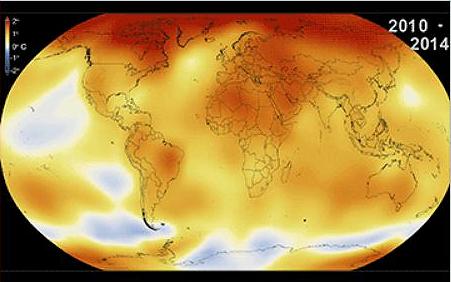 |
| Reviews and Templates for Expression We |
Earth Heating Up: 2014 Warmest Year in Modern Record
The 10 warmest years on record, with the exception of 1998, have now occurred since 2000. This trend continues a long-term warming of the planet, according to an analysis of surface temperature measurements by scientists at NASA’s Goddard Institute of Space Studies in New York.

Heat map composite showing the years 2010-2014 (Image courtesy NASA)
“NASA is at the forefront of the scientific investigation of the dynamics of the Earth’s climate on a global scale,” said John Grunsfeld, associate administrator for the Science Mission Directorate at NASA Headquarters in Washington.
NASA monitors Earth’s vital signs from land, air and space with a fleet of satellites, as well as airborne and ground-based observation campaigns.
“The observed long-term warming trend and the ranking of 2014 as the warmest year on record reinforces the importance for NASA to study Earth as a complete system, and particularly to understand the role and impacts of human activity,” said Grunsfeld.
Since 1880, Earth’s average surface temperature has warmed by about 1.4 degrees Fahrenheit (0.8 degrees Celsius), a trend driven by the increase in carbon dioxide and other human emissions into the planet’s atmosphere. The majority of that warming has occurred in the past three decades.
“This is the latest in a series of warm years, in a series of warm decades. While the ranking of individual years can be affected by chaotic weather patterns, the long-term trends are attributable to drivers of climate change that right now are dominated by human emissions of greenhouse gases,” said Gavin Schmidt, director of the Goddard Institute of Space Studies, GISS.
While 2014 temperatures continue the planet’s long-term warming trend, scientists still expect to see year-to-year fluctuations in average global temperature caused by phenomena such as El Niño or La Niña. These phenomena warm or cool the tropical Pacific and are thought to have played a role in the flattening of the long-term warming trend over the past 15 years. But 2014’s record warmth occurred during an El Niño-neutral year.
In an independent analysis of the raw data, released Friday, NOAA scientists also found 2014 to be the warmest year on record.
“NOAA provides decision makers with timely and trusted science-based information about our changing world,” said Richard Spinrad, NOAA chief scientist. “As we monitor changes in our climate, demand for the environmental intelligence NOAA provides is only growing.”
“It’s critical that we continue to work with our partners, like NASA, to observe these changes and to provide the information communities need to build resiliency,” said Spinrad.

California’s Lake Shasta at 24% total capacity and 41% of the historical average Oct. 29, 2014 (Photo by Don Barrett)
Regional differences in temperature are more strongly affected by weather dynamics than the global mean. For example, in the United States in 2014, parts of the Midwest and East Coast were unusually cool, while Alaska and three western states – California, Arizona and Nevada – experienced their warmest year on record, NOAA scientists found.
The GISS analysis incorporates surface temperature measurements from 6,300 weather stations, ship-based and buoy-based observations of sea surface temperatures, and temperature measurements from Antarctic research stations.
GISS is a NASA laboratory managed by the Earth Sciences Division of the agency’s Goddard Space Flight Center, in Greenbelt, Maryland. The laboratory is affiliated with Columbia University’s Earth Institute and School of Engineering and Applied Science in New York.
NASA scientists analyzed the raw data using an algorithm that takes into account the varied spacing of temperature stations around the globe and urban heating effects that could skew the calculation.
The result is an estimate of the global average temperature difference from a baseline period of 1951 to 1980.
NOAA scientists used much of the same raw temperature data, but a different baseline period. They also employ their own methods to estimate global temperatures.
The UK’s Met Office released provisional full year figures for 2014 showing 2014 to be the UK’s warmest and fourth wettest year in records dating back to 1910.
“It is also the warmest year on record in the Central England Temperature series, which dates back to 1659 and is the world’s longest running instrumental temperature series,” the Met Office said in a statement.
The UK’s mean temperature for the year is 9.9 degrees Celsius, which is 1.1 degrees Celsius above the long-term (1981-2010) average and beats the previous record of 9.7 degrees Celsius set in 2006.
This year’s record means that eight of the UK’s top 10 warmest years have happened since 2002.
In another measurement, also released today, the nonprofit organization Berkeley Earth says, “The global surface temperature average, including both land and sea, for 2014 was nominally the warmest since the global instrumental record began in 1850. However, within the margin of error (0.05 degrees Celsius), it is tied with 2005 and 2010, and so Berkeley Earth scientists say they can’t be certain it set a new record.”
Berkeley Earth was conceived by Richard and Elizabeth Muller in early 2010 when they “found merit in some of the concerns of skeptics.”
They organized a group of scientists to reanalyze the Earth’s surface temperature record, and published their initial findings in 2012. Berkeley Earth became an independent nonprofit 501(c)(3) in February 2013.
Key findings of the Berkeley Earth analysis:
For land, 2014 was nominally the 4th warmest year since 1753, when the land surface temperature record began.
For oceans, 2014 was the warmest year on record since 1850. The second warmest year was 2010, and 2014 exceeds this by +0.078 degrees Celsius.
For the contiguous United States, 2014 ranked nominally as the 38th warmest year on record since 1850 (+0.23 degrees Celsius).
The warmth in 2014 is not uniform across the Earth. The U.S. state of Michigan in 2014 recorded its 14th coldest year (-1.12 degrees Celsius relative to the 1961-1990 average).
In contrast, the U.S. state of California, in the midst of a severe drought, recorded its warmest year to date (+1.92 degrees Celsius) besting the previous record by 0.76 degrees Celsius.
Internationally, Germany (+2.10 degrees Celsius), the United Kingdom (+1.33 degrees Celsius), Sweden (+2.23 degrees Celsius) and several other European countries also set all-time records for high annual average temperature, as did the continent of Europe as a whole (+1.69 degrees Celsius).
In total, scientists at Berkeley Earth estimate that 8.4 percent of Earth’s surface and 5.6 percent of its land surface set all-time record high annual averages in 2014; 0.11 percent of the Earth’s surface and 0.03 percent of land set all-time record low annual averages in 2014.
Our margin of uncertainty was remarkably small – 0.05 degrees Celsius with 95 percent confidence – due to the inclusion of data from over 30,000 temperature stations, and by the use of optimized statistical methods.
“Even so,” said Berkeley Earth in a statement, “the highest temperature year could not be distinguished. That is, of course, an indication that the Earth’s average temperature for the last decade has changed little; the 10 warmest years all occur since 1998.”
|
|
|
|
Copyright 2011 Energy and Technical Services Ltd. All Rights Reserved. Energyts.com |